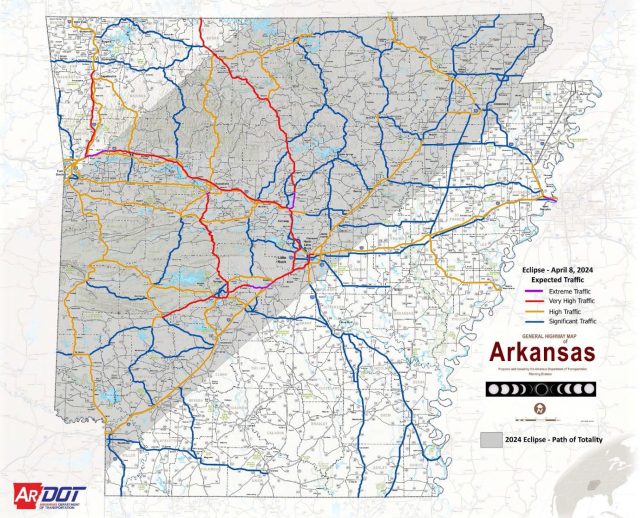
LITTLE ROCK — The Arkansas Department of Transportation (ARDOT) has released a Traffic Management Plan (TMP) in preparation for much of the state being in the path of totality during the Great American Total Solar Eclipse on April 8, 2024.
“We expect a heavy influx of visitors to our state to view this rare phenomenon, and we’re preparing accordingly,” said ARDOT Director Lorie Tudor. “Our goal is to get everyone where they need to go as safely and efficiently as possible.”
The TMP includes traffic forecasting data, traffic reduction strategies, traffic flow enhancements, as well as information about ARDOT’s Traffic Management Center and Communications Division.
The Moon will pass between the Sun and the Earth, creating a 117.9-mile-wide shadow that will enter the southwest tip of Arkansas near De Queen at 1:46 PM Central Daylight Time (CDT). The shadow will move along a northeasterly path until it exits the state near Pocahontas at approximately 2:00 PM. The period of total darkness for any particular location along the center of the path will be just over four minutes.
Many tourists are expected to travel to view the Eclipse, likely making this the largest tourism event in Arkansas history. The plan said the state expects up to 1.5 million visitors from outside the state, along with 500,000 Arkansans who will travel from their residences to the path of totality, for a total of two million people who will visit the viewing area.
“To develop a conservative estimate of visiting vehicle trips, ARDOT assumed that all visitors will travel in motor vehicles and an average of 2.862 passengers will travel in each vehicle. This would result in the influx of approximately 700,000 extra vehicle trips into the path of totality. To estimate the date of travel for visitors, travel patterns from the most recent total eclipse in 2017, which also occurred on a Monday, were reviewed. The review showed that approximately 30 percent of the sightseers arrived on the day of the event, and up to 80 percent left immediately after sunlight returned. The study team expects similar travel patterns for this Eclipse, leading to large increases in traffic volumes on ARDOT highways and the local road system,” said ARDOT in the report,
ARDOT used data from states that were in the path of the 2017 Total Solar Eclipse, along with state park reservation data for the upcoming Eclipse, to help anticipate travel patterns and peak travel dates and times. With this data, ARDOT was able to identify locations where high or extreme traffic volumes are expected immediately following the Eclipse.
“Forecasted post-Eclipse volumes will exceed capacity on many roads, and it is not practical to sufficiently increase roadway capacity for a one-day event. Most of the public will not be expecting the extreme congestion caused by the Eclipse,” the report stated.
The TMP includes traffic reduction strategies such as:
Stay a while — Data from the 2017 Eclipse suggests that up to 80 percent of the traffic is expected to leave immediately after the Eclipse passes over, putting a tremendous strain on the roadway network. By staying in Arkansas longer, travelers can avoid extreme congestion, and congestion levels for those who need to leave will be moderated. Extended stays also provide more opportunities for Arkansas businesses. Arkansas State Parks are already planning to continue their festivals after the Eclipse is over. Promoting activities hosted by the State Parks and other festival locations that encourage tourists, especially those in RVs, to stay longer will be beneficial to reduce the concentrated traffic demands.
Work from home — The path of totality passes through several metropolitan areas where commuting traffic makes up a sizeable percentage of total roadway users. The post-Eclipse visitor rush will coincide with the afternoon commuting peak, furthering traffic congestion. In some cases, what is normally a half-hour commute could take several times longer. Where the 2work type allows, businesses and employees alike could be best served by avoiding commuting on this day by working from home, adjusting schedules, and other means.
School closings — Several school districts in Arkansas have already announced closures on the day of the Eclipse, allowing students to experience this event with their families, and also avoiding the logistical challenges of operating schools and school buses on this day.
The plans also calls for reduction of oversize loads and a communication effort with truckers so they can make an informed decision on their travel plans. The TMP also includes traffic flow enhancements such as reduced construction activity, identify and mitigate potential bottlenecks, and suggest alternate routes to avoid traffic chokepoints.
ARDOT will be coordinating with other agencies and officials at the state, county, and local levels before, during, and after the Eclipse to ensure consistent messaging and communication is provided to citizens and visitors.
The TMP serves as a “living document” that may be updated and edited as needed.
“The 2024 Eclipse will generate high levels of traffic congestion resulting in unavoidable delays. This plan will guide us as we strive to keep traffic flowing through this memorable event. ARDOT encourages all visitors to enjoy this unique experience, and to make safety their top priority as they travel to and from the event,” the document concludes.
(Full version of the TMP: www.ardot.gov/wp-content/uploads/10.11.2023-Solar-Eclipse-TMP-LR2.pdf.)







